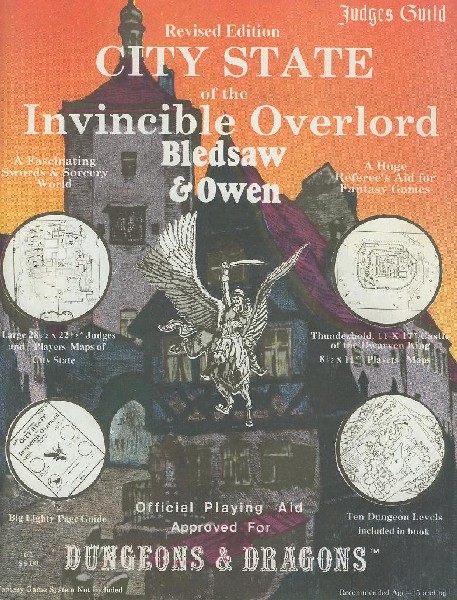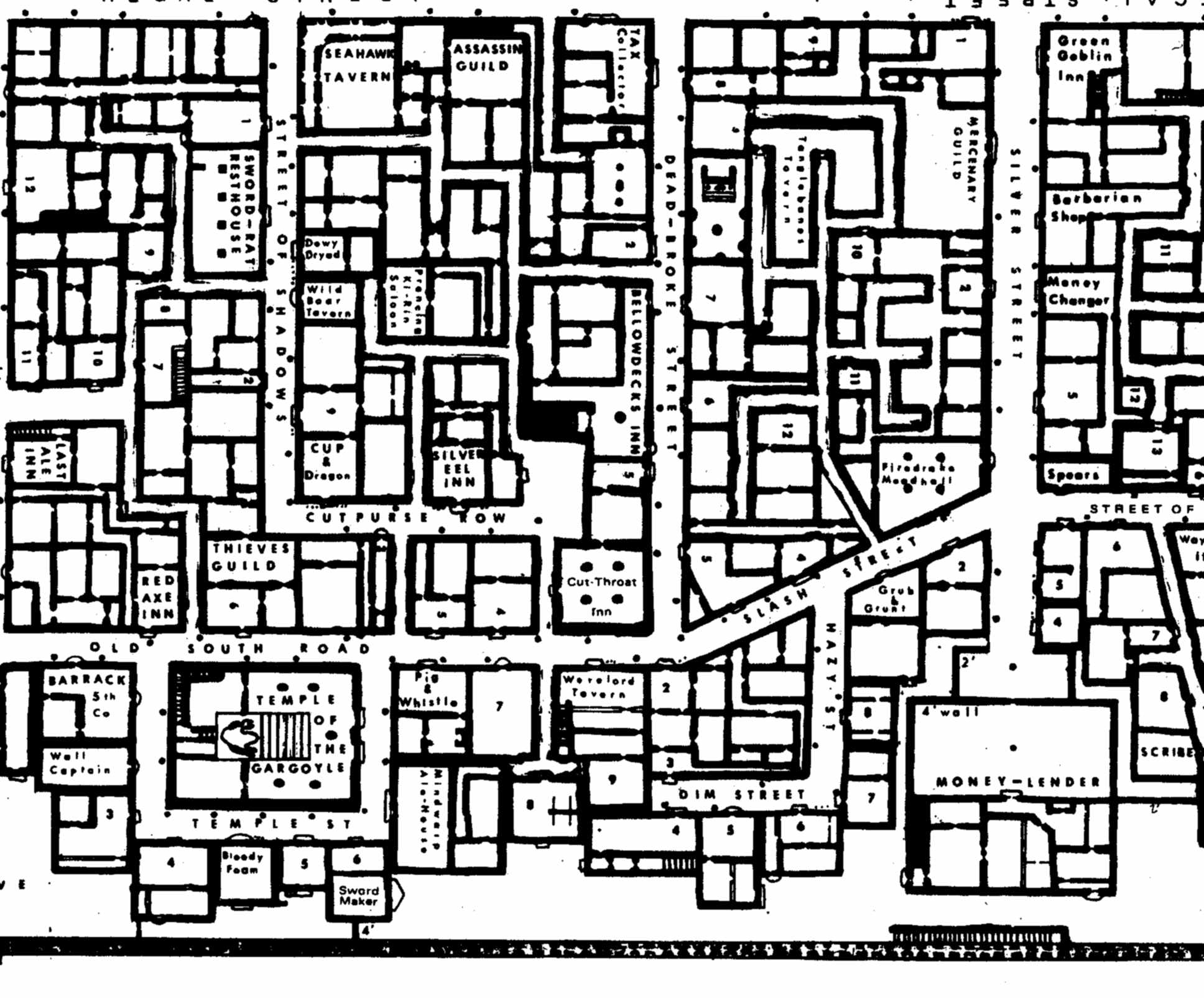City State of the Invincible Overlord (Judges Guild)
Experiences and Reminisces: I remember playing this one in my friend’s dining room. This was a day of vivid memories for me. My friend had a dog that peed whenever you were nice to it. Someone spilled coke on my character sheet. And for the first time ever, I saw a Judges Guild map. It was on that pebbly golden stock which felt absolutely great. It even looked old. I read on the Necromancer lists that most printers cannot obtain anything even close, so the hope of reproducing them is dim at best. And, best of all, most of the map was blank. It was the players map, which contained only the location and names of the streets and public squares. I caught of glimpse of the GM’s map, and I knew that a vastly detailed city awaited us, just waiting for us to explore.
I grew up on Tolkien, and most of my experiences with D+D to that point were based on the presumption that all fantasy ultimately derived from Lord of the Rings. After all, the four possible races in early editions—human, elf, dwarf, and Halfling—came right form Professor T’s pages. But the City-State gave a glimpse of a fantasy world based on the writings of Howard, Vance, Norton, and Leiber. This was low fantasy, and it offered a whole new world of possibilities. Here, trolls serve as barkeeps and goblins, who lived on a reservation outside of town, came in to perform menial work. There were slaves and red-skinned barbarians and a table to determine a woman’s measurements and “inclinations”—politically incorrect stuff that would never see the light of day in a published gaming supplement these days. But the whole thing was incredibly appealing to my young soul. This was not a world of squeaky-clean good vs. palpable evil. Everything existed in shades of grey, and we could be as bad as we wanted to be.
Our GM fully got us into the spirit of things. My duelist character (a Dragon Magazine subclass, if I recall correctly) wound up getting wings after falling into a magical well. Our party nearly trashed one tavern after picking a fight with some orcish patrons. We all longed after the amazons—beautiful, dangerous, and contemptuous of us, so we just knew that they had good sense.
What Made it Popular? This was the first published city adventure ever, so for a while it stood alone. TSR would go years before they attempted a similar environment, and in my mind they only ever really came close when they adapted Fritz Leiber’s Lankmahr in the late ‘80’s. But every fantasy RPG city I have seen since has been pretty much designed with a single concept in mind, with everything flowing out logically and holistically from that central organizing concept. Usually, a city exists to serve some narrative or thematic purpose in the campaign (much like Minas Tirith and Minas Morgul glare at each other across the pages of Return of the King). CSIO is a chaotic mess, a seemingly random assemblage of taverns, cults, shops, and personalities. Order is supplied by the Overlord, who rules by terror and force. Gods in disguise run shops and cellars open into vast dungeons. Harlots, thieves and lawyers compete to separate the party from their money. This is an environment where anything can happen, and since power goes to the strongest, the sky is the limit for an ambitious character. And let’s not forget those maps…
Test of Time. After several printings and editions of the original work, two subsequent versions were published. The Mayfair Games revival lost more than it gained. The Necromancer Games 3.5 update went back to the content and spirit of the original (although it came with but one map, on plain ol’ glossy paper. *sigh*). The fact that these babies doubled in price on eBay in just a few years speaks volumes about the demand for quality products with an old school feel.
I’ve dusted off the City-State for at least a half-dozen campaigns I have played. It has got to be my most used campaign supplement, and even after all these years it does not feel stale. Sometimes I place it in the Wilderlands, its original campaign home. Sometimes, I shoehorn it into whatever campaign world I happen to be using at the time. As soon as players see the map, they want to explore. I enjoy sharing that magical moment of anticipation with new players. There is enough adventure and intrigue in one quarter of the city-state to keep players out of the dungeon for months. The rumors listed at each location provide dozens of adventure hooks for a GM who is comfortable making things up on the fly.
What would I change? While each shop and tavern is an adventure unto itself, there is not a lot of interaction between the residents of the City-state. Everyone exists in their own little worlds, and the same kind of static ecosystem that was characteristic of old school dungeons seems to inform the City-state. So we get a thieves’ guild, but outside of their home base, we know little about the effect they have on the city. A GM who really wants to breathe life into the City-state, or one who wants to run complex adventures there, will have his or her work cut out for them. Once the players start stirring things up, though, connections should be easy to forge. Once again, though, this mandates a GM who can think on his feet, so be ready.
I saw a copy of the 1979 edition on eBay for $26. It’s in reach, so there’s no excuse for not getting it!
No comments:
Post a Comment